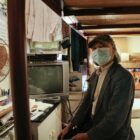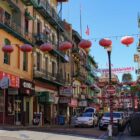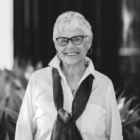When wildfires raged in the western United States in 2020 turning the sky orange and the air toxic, residents in San Francisco’s Chinatown, a neighborhood deemed by the city to be particularly vulnerable to the consequences of climate change, faced respiratory and other health effects.
“The air was very stuffy during wildfire season,” Weihong Wu, who lives with her husband in a single-room occupancy building in the neighborhood, said in Cantonese. “If I opened the window, I didn’t feel well, but if I didn’t open the window and let the fresh air in, it felt so stuffy. It’s like we can’t breathe.” Wu said her throat was dry and painful.
As climate change exacerbates droughts, wildfires, floods, storms and other catastrophes, community organizations in the city are racing to put systems in place to both measure its impacts on residents and to provide the tools they need to support themselves during disasters.
Eddie Ahn, executive director of Brightline Defense, an environmental justice nonprofit in San Francisco, is on the frontlines of this work. He serves on several city commissions, including as president of San Francisco’s Commission on the Environment.
In multiple interviews with the San Francisco Public Press, Ahn described how Brightline and its partners engage in environment policy actions, highlight disparities in air quality data, provide air filtration devices to residents, and pursue other climate justice and sustainability work.
Below are excerpts from interviews with Ahn, which have been edited for length and clarity.
What personally inspired you to join Brightline Defense and pursue environmental justice work?
I have a background working in social justice issues. This was as a law student — I originally worked at the Assembly Judiciary Committee as an extern and got to work on a wide variety of legal issues associated with the environment and civil justice.
I like environmental justice work specifically because of the field’s interaction with a lot of different communities. I’m able to work with diverse communities and how they relate to the environment. Diversity is a lot of different things — it can be by income, race, cultural history or geographic experience. So, being able to experience all of that while working on such an overwhelming problem like climate change has been a joy and a challenge.
In 2021, Brightline released the results of a survey about air quality issues experienced by people living in single-room occupancy buildings across San Francisco. Since then, what efforts have been made to mitigate some of the concerns expressed by residents?
The challenges are ongoing. One, there’s been a lot of good reporting on this even recently talking about how many of the buildings, particularly on the west side of San Francisco and neighborhoods like Chinatown, Bayview-Hunters Point on the east side of San Francisco, really are filled with essentially aging buildings that don’t have things like a modern HVAC system — air conditioning, air filtration.
Those larger projects to retrofit these buildings or make them more resilient, those are typically really expensive projects — like we’re talking in the millions or tens of millions of dollars at least. So, in the meantime, trying to get them individual air filtration units can be considered a stopgap measure.
There are even more emergency-oriented measures that we worked on in the past, so that would be something like creating a do-it-yourself air filtration system, like taking a MERV 13 filter and stitching it together with a box fan using duct tape. But that in our minds is very much like a very last-minute measure — if you can’t access an individual air filtration unit, that is the measure you should be taking. But for us, we’ve really been pushing for increased funding and access to individual air filtration programs created by, for instance, the Bay Area Air Quality Management District.
Is the organization taking any steps to support older adults and other residents in single-room occupancy buildings, specifically those who are disproportionately impacted by climate change?
Brightline has been working with SRO tenant leaders for some time now, and this is a program that’s originally organized by Central City SRO Collaborative. They’ve maintained offices in the Tenderloin, but really, they serve SRO tenants across eastern San Francisco. We’re talking Mission District to South of Market to the Tenderloin to Chinatown as well.
Just to focus on the SRO population: Seniors and SRO families are probably the two populations I worry a ton about because the vulnerabilities are very unique for each. Seniors, they have easily interplay of different health issues at that point. And one of the kind of understandings about SRO seniors is that it’s harder for them to move out of SROs at the end of the day. This is often like their last housing unit they’ll live in before they pass. And then, for SRO families, you’re talking potentially crowding three, four people in an 8-by-10 unit. That happens quite a bit in Chinatown SROs, too. That itself presents its own set of issues for that whole age range that’s within the household, right? So, it’s everything from the lack of privacy, mental health issues, to having to share that air within that space, and not have the resiliency, the infrastructure, that you need to protect against climate change.
Thinking through policy changes at the end of the day: We have done direct distribution of air filtration systems. We did a program with Chinatown Community Development Center about two years ago where we distributed about 100 air filtration units in Chinatown, the Tenderloin, South of Market areas. But it only goes so far. Part of the reason why our nonprofit exists is to affect policy change. It’s not just about, you know, 50 units here, 100 units there; it’s hopefully trying to increase access to thousands of units at a time.
Could you describe Brightline’s air quality monitoring project, including the reasons behind launching this program in San Francisco?
It started out originally in community partnership. We were doing initial meetings through the nonprofit partners of our programs, so that’s both Community Youth Center, CYC of San Francisco, and Central City SRO Collaborative. So, CYC, that partnership is a youth leadership program. It’s meant to really connect high school students to environmental issues among other things. And air quality kept coming up because wildfires were starting a bit earlier. And so, there was an increasing awareness of, “This might be an ongoing issue,” and “What are the conditions in our local communities?” And that was a similar string we found in Central City SRO Collaborative and our work with SRO tenant leaders there, too.
Through that kind of community input, we applied for a state air quality monitoring grant. We were awarded it in late 2019. And then in January 2020, we were super excited to start up the program with a technical partner. Clarity is the partner that we’ve used a lot. I don’t know if you’ve seen these devices, but they’re essentially the size of a shoebox, you know, solar panel on top. They’re very resilient devices. And the good thing about them is that you can just throw them up and not worry as much about them over a long period of time.
With the Air Quality Monitoring Program, that was thrown for a loop because of the pandemic, which then came down in March 2020. So, it did delay our planning a bit for a few months.
And we were originally planning to roll it out in say, like, October, November of that year. But then the wildfires hit in August and September, which is when we started rushing out the air quality sensors, and we had done like a ton of community surveying over street corners where we should site these sensors. And in essence, it takes a lot of coordination and work.
And is the data being shared with the people who are in neighborhoods with poor air quality?
Definitely. We do try to break this down into more concise data reports and analyses. We’ve done this in various ways. We’ve done presentations before youth and SRO tenant leaders. We’ve done it in the form of writing. Social media and communications are another big part of what we do. Of course, talking to traditional media, too, is part of it as well.
But it tends to be more driven by, “What’s the crisis at the moment?” People often take the air around them for granted, and it comes baked into their existence. Only when you have extreme climate change events like wildfires that people are like, “Oh my goodness, what is the air right now? And where’s the air report?” And I think part of our work has been good in that — keeping people apprised.
Brightline has been doing a lot of work around the policy of environmental justice mapping. I was wondering if you could share a little bit more about that specifically. What are you trying to accomplish, including with CalEnviroScreen?
I think generally when we try to address issues around climate change, we want to make sure that no community is left behind. And for environmental justice mapping, the point of it is to ensure that we are having equity when we create policies that address environmental issues.
CalEnviroScreen has had a long history now in the state of California. It was originally created under state legislation SB 535 as a way to define what is a so-called disadvantaged community.
The challenge in CalEnviroScreen is that it’s not a bad tool, but it has struggled to capture the Bay Area as a region accurately in the past. And they’ve gone through several versions. The earliest versions did not include Bayview-Hunters Point, and that was like a huge struggle to just even get the city and county of San Francisco recognized as having a so-called disadvantaged community that needed investment. And now, Bayview-Hunters Point, I think, is pretty well recognized at this point as a community deserving of investment and economic opportunity.
The next level challenge has been really trying to encompass more South of Market, more of the Tenderloin. So, there are little slivers of SOMA and the Tenderloin, but none of the Mission District and none of Chinatown is included currently in the map. And at Brightline, we filed essentially a coalition advocacy letter to argue for improvements to the changes. It’s very clear that there’s a history of incidents in Chinatown and in the Mission District to have racial discrimination, disinvestment, and, overall, there are unique environmental injustices that are being suffered in each community, too.
So, SROs, which we’ve talked about in the past, are older buildings built in the 1900s. And they don’t have the resiliency built into that. They don’t have the infrastructural improvements needed to withstand climate change effects. So, if you have massive climate change events like wildfires, for instance, that are pouring smoke into cities, our most vulnerable are low-income households and families that can’t afford an air filtration unit. And that is typically an SRO tenant, for instance, or an SRO family. So that’s the kind of targeting I think we need to demand of our environmental justice mapping tools.
What do you think about the Heat and Air Quality Resilience Plan launched by the city?
It’s a good start. I did look it over. And we have been supportive of their efforts around heat mapping. A big question is, “Where does the funding come from at the end of the day?” I think there are pathways for implementation, but people need to be prepared that this will have costs, and it will require enormous resources to do correctly.
Do you think, prior to launching this report, the steps that the city has taken to protect older residents and vulnerable populations have been adequate?
Overall, we could always be moving faster. I think that’s the challenge is that from an advocacy standpoint, we’re not moving quickly enough whether it’s serving our senior populations or addressing climate change. I do think that we’re grappling with problems in the state that we’re in, we should be creating big alarm bells for people. In other words, this is not something we need to fix 10 years from now. This is something we need to do now.
I think this is also true of just, philosophically, climate change as an issue — the idea that we can fix issues related to climate change like 20, 30 years from now is increasingly not true.
And yeah, I do think we need very aggressive actions in the next few years to even get to a stage where people are OK, and that they are hopefully surviving, if not thriving.
This Q&A, part of a series of stories on the health impacts of climate change on older adults, was produced with the support of a journalism fellowship from the Gerontological Society of America, the Journalists Network on Generations and the Archstone Foundation. Zhe Wu translated the interview with Weihong Wu.










